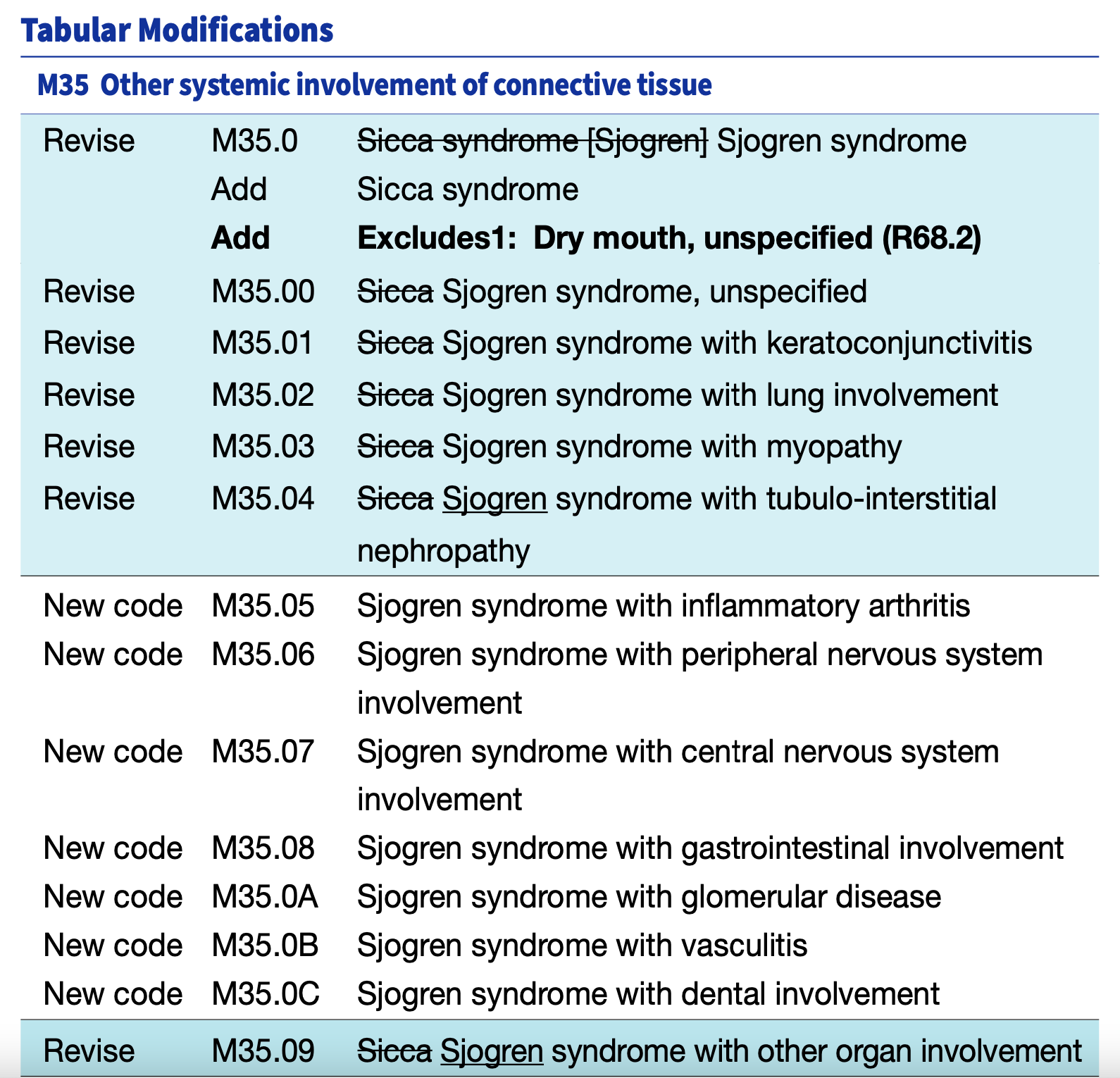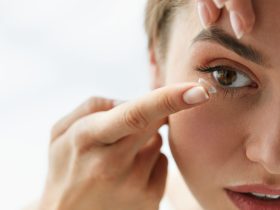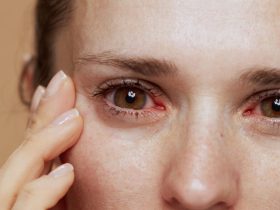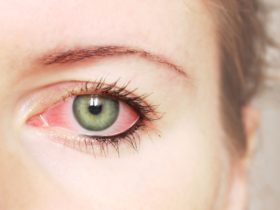ICD 10 Code Dry Eyes is H04.123. This code is used to diagnose and treat dry eye syndrome.
Dry eye syndrome, also known as keratoconjunctivitis sicca, affects millions worldwide. It occurs when tears fail to provide adequate lubrication for the eyes. Common symptoms include redness, irritation, and a gritty sensation. Factors such as aging, environmental conditions, and prolonged screen use contribute to this condition.
Treatments range from artificial tears and prescription medications to lifestyle changes. Identifying and managing dry eye syndrome is crucial for maintaining eye health and comfort. Proper diagnosis using the ICD-10 code H04. 123 ensures effective treatment and relief for affected individuals. Prioritizing eye care can significantly improve quality of life.
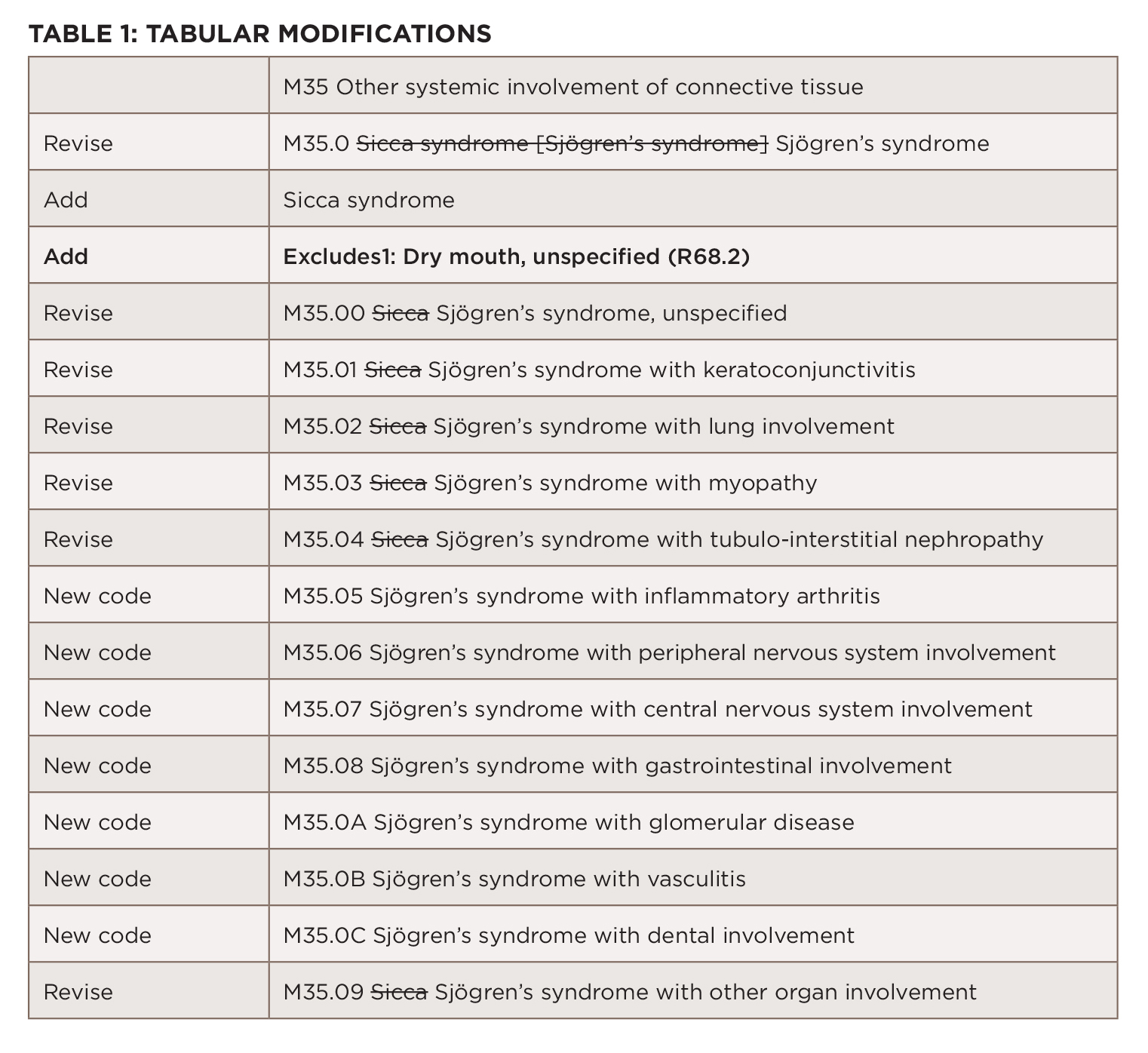
Credit: www.the-rheumatologist.org
Introduction To Icd 10 Dry Eyes
Dry eyes are a common condition. They cause discomfort and irritation. The ICD 10 code helps in diagnosing and treating this issue. In this section, we will explore what ICD 10 is. We will also discuss the basics of dry eyes.
What Is Icd 10?
ICD 10 stands for International Classification of Diseases, Tenth Revision. It is a system used by healthcare providers. This system classifies and codes all diagnoses, symptoms, and procedures. It helps in maintaining accurate health records.
The ICD 10 code for dry eyes is H04.12. This code assists in identifying and treating dry eyes.
Basics Of Dry Eyes
Dry eyes occur when your eyes do not produce enough tears. They can also happen if your tears evaporate too quickly. This condition can be caused by various factors.
- Age
- Environment
- Medications
- Medical conditions
Symptoms of dry eyes include:
- Burning sensation
- Redness
- Blurred vision
- Sensitivity to light
Treatment options are available to manage dry eyes. These include:
- Artificial tears
- Prescription medications
- Lifestyle changes
Consult a healthcare provider for proper diagnosis and treatment.

Credit: www.researchgate.net
Common Symptoms
Dry eyes can be quite uncomfortable and affect daily activities. Recognizing the common symptoms helps in identifying and seeking timely treatment.
Irritation And Redness
One of the most prevalent symptoms of dry eyes is irritation. Your eyes may feel gritty or like there is sand in them. This sensation can be persistent or occur intermittently.
Redness is another common indicator. The whites of your eyes may appear red or bloodshot. This is due to the lack of moisture and lubrication.
- Constant itching
- Burning sensation
- Feeling of something in the eye
Blurred Vision
Dry eyes can also lead to blurred vision. This happens because your tears are not forming a smooth layer over your eyes.
Blurred vision can make it difficult to read, use a computer, or drive. It may come and go, often worsening as the day progresses.
| Symptom | Description |
|---|---|
| Fluctuating vision | Vision clarity changes throughout the day |
| Eye fatigue | Eyes feel tired or strained easily |
Recognizing these symptoms early can help in managing dry eyes effectively.
Causes Of Dry Eyes
Dry eyes, also known as keratoconjunctivitis sicca, can cause discomfort and vision issues. Understanding the causes of dry eyes can help in managing and preventing the condition.
Environmental Factors
Environmental conditions can significantly impact the moisture in your eyes. These factors include:
- Wind: Strong winds can dry out your eyes quickly.
- Air conditioning: AC units reduce humidity, causing dryness.
- Heating: Heaters also reduce air moisture, leading to dry eyes.
- Smoke: Exposure to smoke irritates and dries the eyes.
- Computer screens: Prolonged screen time reduces blinking, causing dryness.
Medical Conditions
Certain medical conditions can lead to dry eyes. These include:
- Rheumatoid arthritis: This autoimmune disease can affect tear production.
- Sjögren’s syndrome: This disorder causes dry mouth and dry eyes.
- Thyroid disorders: These can disrupt the glands that produce tears.
- Diabetes: High blood sugar levels can affect tear production.
- Vitamin A deficiency: This vitamin is crucial for eye health.
Understanding these causes can help in taking preventive measures and seeking appropriate treatment for dry eyes.
Diagnosis Process
The diagnosis process for ICD-10 Dry Eyes involves several steps to ensure accurate identification. This process helps in determining the severity and the best treatment options.
Eye Examination
An eye examination is the first step in diagnosing dry eyes. During this examination, the eye doctor will:
- Ask about your symptoms
- Review your medical history
- Check your eye health
The eye doctor may also use a slit lamp. This special microscope helps in examining the eye’s surface in detail.
Diagnostic Tests
Several diagnostic tests help determine the cause of dry eyes. Some common tests include:
| Test Name | Description |
|---|---|
| Schirmer Test | Measures tear production using a small strip of paper. |
| Fluorescein Staining | Uses dye to highlight damage on the eye’s surface. |
| Tear Breakup Time | Checks how quickly tears evaporate from the eye surface. |
These tests provide valuable information about tear production and eye health. With this data, the doctor can recommend effective treatments.
Treatment Options
Dry eyes can be uncomfortable. There are many treatment options available. These range from simple over-the-counter solutions to prescription medications.
Over-the-counter Solutions
Over-the-counter solutions are easy to find. They can provide quick relief for dry eyes.
- Artificial Tears: These lubricate the eyes.
- Eye Ointments: These help keep eyes moist overnight.
- Warm Compresses: These can improve tear quality.
Artificial tears are the most common. They are available in many brands. You can use them several times a day.
Eye ointments are thicker than artificial tears. Use them before bed. They can blur vision if used during the day.
Warm compresses are simple to use. Place a warm cloth over your eyes. This can help stimulate tear production.
Prescription Medications
If over-the-counter options don’t work, see a doctor. They may prescribe stronger medications.
| Medication | Function |
|---|---|
| Cyclosporine | Increases tear production |
| Autologous Serum Drops | Made from your own blood |
| Lifitegrast | Reduces inflammation |
Cyclosporine helps to increase tear production. It is a common prescription for dry eyes.
Autologous serum drops are unique. They are made from your own blood. They are especially useful for severe dry eyes.
Lifitegrast reduces inflammation in the eyes. It is a newer medication but very effective.
Lifestyle Changes
Dry eyes can be uncomfortable and affect daily life. Adopting lifestyle changes can help manage this condition. Simple adjustments in diet and hydration can make a big difference.
Dietary Adjustments
Your diet impacts eye health. Including certain foods can help alleviate dry eyes.
| Food | Benefits |
|---|---|
| Fatty Fish | Rich in Omega-3 fatty acids, which reduce inflammation. |
| Nuts and Seeds | High in Vitamin E, protecting eyes from oxidative damage. |
| Leafy Greens | Contain antioxidants like lutein and zeaxanthin. |
| Carrots | Loaded with Vitamin A, essential for eye health. |
Incorporate these foods into your daily meals:
- Add flaxseeds to your breakfast cereal.
- Snack on almonds and walnuts.
- Enjoy a salad with spinach and kale.
- Include grilled salmon in your dinner.
Hydration Tips
Staying hydrated is crucial for eye health. Dry eyes often result from dehydration. Here are some effective tips:
- Drink at least 8 glasses of water daily.
- Carry a water bottle to sip throughout the day.
- Limit caffeine and alcohol, as they dehydrate the body.
- Eat water-rich foods like cucumbers and watermelon.
Make hydration a habit. Keep track of your water intake. Use apps or set reminders.
Preventive Measures
Dry eyes can cause discomfort and affect your daily activities. Taking preventive measures can help alleviate symptoms and keep your eyes healthy. Here are some effective ways to prevent dry eyes:
Protective Eyewear
Wearing protective eyewear can shield your eyes from harmful elements. This includes wind, dust, and other irritants. Sunglasses with UV protection are highly recommended. They not only block out harmful rays but also reduce glare, which can strain your eyes.
For those working in environments with irritants, safety goggles are essential. They provide a barrier against particles and chemicals. Choose eyewear that fits well and offers complete coverage for maximum protection.
Proper Screen Usage
Extended screen time is a major cause of dry eyes. Follow the 20-20-20 rule to minimize strain: every 20 minutes, look at something 20 feet away for at least 20 seconds.
Adjust your screen settings to reduce glare and increase comfort. Lower the brightness and use an anti-glare screen protector if necessary. Position your screen at eye level to avoid looking up or down, which can strain your eyes.
Take regular breaks and blink frequently to keep your eyes moist. Blinking helps spread tears evenly and prevents dryness. If needed, use artificial tears or eye drops to maintain moisture.
| Preventive Measure | Description |
|---|---|
| Protective Eyewear | Shields eyes from wind, dust, and UV rays |
| Proper Screen Usage | Reduces eye strain and maintains moisture |
When To See A Doctor
Dry eyes can be a minor inconvenience or a sign of something more serious. Knowing when to seek medical help is crucial. Identifying the right time to visit a doctor can prevent complications and ensure proper treatment.
Warning Signs
Watch out for these warning signs indicating it’s time to see a doctor:
- Persistent dryness lasting more than a few days
- Severe eye pain or discomfort
- Redness or inflammation around the eyes
- Blurred or fluctuating vision
- Increased sensitivity to light
- Unusual discharge from the eyes
If you experience any of these symptoms, schedule an appointment with your doctor promptly.
Specialist Referrals
In some cases, your general practitioner may refer you to a specialist. Here are common types of specialists:
| Specialist | When to See |
|---|---|
| Ophthalmologist | For comprehensive eye exams and specialized treatment. |
| Optometrist | For routine eye exams and managing dry eye symptoms. |
Consulting the right specialist ensures you get the best care and treatment for your dry eyes.
Living With Dry Eyes
Living with dry eyes can be challenging. It affects daily life and comfort. Understanding management techniques and resources helps ease symptoms.
Daily Management
Managing dry eyes daily requires consistent care. Here are some effective strategies:
- Use preservative-free artificial tears regularly.
- Avoid environments with high wind or smoke.
- Take frequent breaks from screens to reduce eye strain.
- Use a humidifier to add moisture to the air.
- Wear sunglasses to protect eyes from UV rays and wind.
| Activity | Recommended Action |
|---|---|
| Reading | Take breaks every 20 minutes |
| Computer Work | Use screen filters and adjust brightness |
| Outdoor Activities | Wear protective eyewear |
Support Resources
Accessing support resources can make living with dry eyes easier:
- Eye Care Specialists: Consult with an ophthalmologist for personalized advice.
- Support Groups: Join online communities for shared experiences and tips.
- Educational Materials: Read books and articles about dry eye management.
- Products: Explore eye care products designed for dry eyes.
Utilizing these resources helps manage symptoms and improve quality of life.
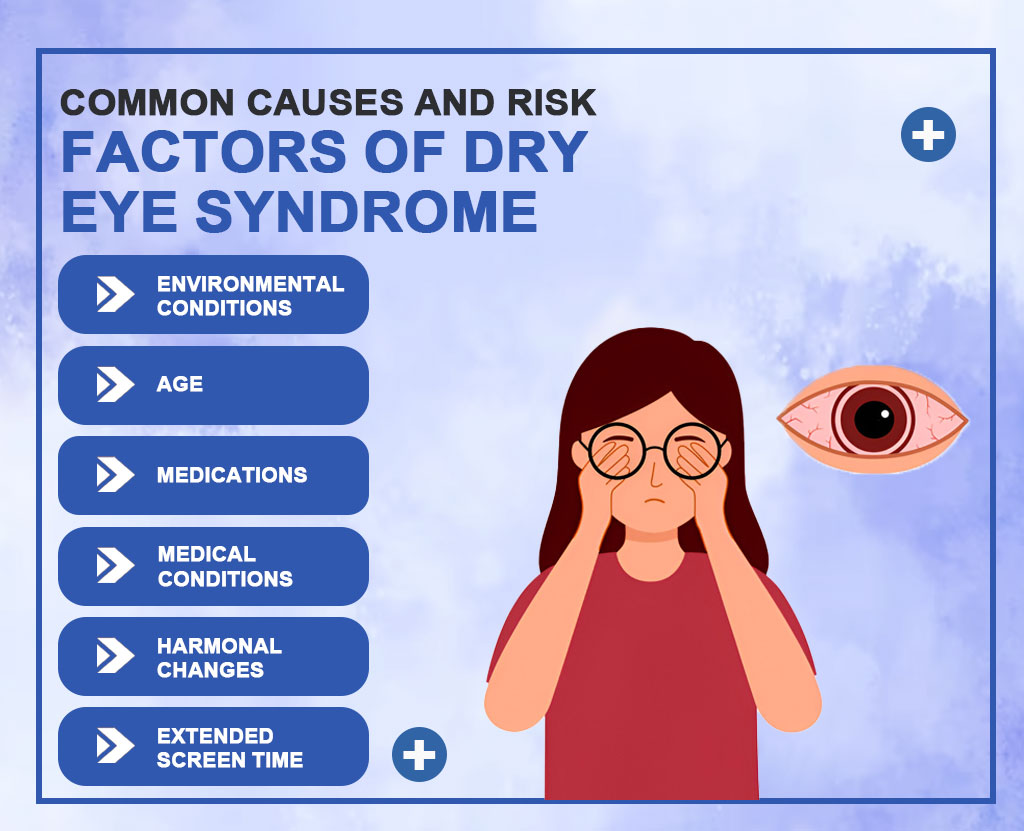
Credit: resilientmbs.com
Future Outlook
The future outlook for ICD 10 Dry Eyes looks promising with advancements in research and technology. These developments bring hope for better diagnosis and treatment options for patients suffering from dry eyes.
Research And Innovations
New research is uncovering the causes of dry eyes. Scientists are working on treatments that target these causes. Innovations in technology are helping doctors diagnose dry eyes more accurately.
- Advanced imaging tools provide detailed views of the eye.
- Artificial intelligence helps in early detection.
- New drugs are being tested in clinical trials.
Researchers are also exploring natural remedies. They study the effects of diet and lifestyle on dry eyes. This could lead to non-invasive treatment options in the future.
Patient Stories
Many patients have shared their experiences with dry eyes. These stories highlight the impact of new treatments. Here are a few:
| Patient | Experience |
|---|---|
| John | John tried a new eye drop. It reduced his symptoms significantly. |
| Susan | Susan used a device that moistens the eyes. She feels much better now. |
| Mike | Mike followed a special diet. His dry eyes improved over time. |
These stories inspire hope. They show that new treatments can make a big difference. Patients report better quality of life and less discomfort.
Frequently Asked Questions
What Is The Icd-10 Code For Dry Eyes?
The ICD-10 code for dry eyes is H04. 12.
How Is Dry Eyes Diagnosed?
Dry eyes are diagnosed through patient history, eye exams, and specific tests like the Schirmer test.
What Causes Dry Eyes?
Dry eyes are caused by decreased tear production or increased tear evaporation.
What Are Common Symptoms Of Dry Eyes?
Common symptoms include redness, itching, burning, and a gritty sensation in the eyes.
How Can You Treat Dry Eyes?
Treatments include artificial tears, lifestyle changes, and sometimes prescription medications.
Conclusion
Managing dry eyes effectively can enhance your quality of life. Understanding ICD-10 codes aids in accurate diagnosis and treatment. Always consult healthcare professionals for personalized care. By staying informed, you can better navigate and address dry eye symptoms. Take steps today for healthier, more comfortable eyes.

